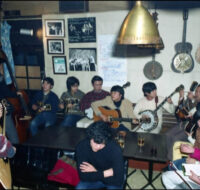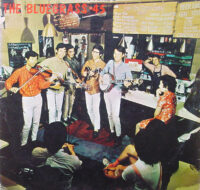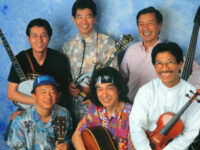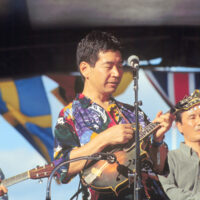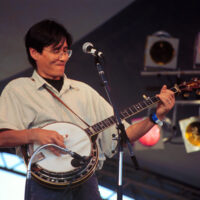
“More than a band, these six friends from Kobe, Japan, have shared 50 years of friendship, musicianship, and a passion for music that has promoted and championed bluegrass as a culture, genre, and lifestyle all over the world.” So says Robert H. Dyar Jr, the Producer and Co-Director of the forthcoming documentary film featuring Bluegrass 45.
The extroverted guitar player Tsuyoshi “Josh” and his older brother Akira Otsuka (mandolin); two other brothers Toshio (bass) and Saburo Watanabe (Inoue) (banjo) and; Chien-Hua Lee; and Hsueh-Chieng “Ryo” Liao – who, like Chien-Hua Lee, is from China – as Bluegrass 45 have grown into an international phenomenon. That the six have maintained relatively good health and that only one member – Akira Otsuka, who resides in the USA – has become detached is remarkable.
2017 was the 50th anniversary of the formation of Bluegrass 45.
Akira Otsuka shares a bit of information about the environment that nurtured the talented musicians of the day …
“Kobe, Japan, is located about 250 miles west of Tokyo and is one of the biggest port towns in Japan. A tiny coffee house called Lost City in Motomachi section of downtown Kobe, was modelled in mid-1960s after New York City coffee houses by a Taiwanese gentleman Guo Guang-sheng. A second owner, Kenji Nozaki, was an excellent singer and banjo player who, in addition to running the coffee house, used to entertain the patrons. A fiddle player who often accompanied Kenji was Shoji Tabuchi, now a big star performing in Branson, Missouri. It was a bluegrass paradise, if you like, – they had a large collection of LPs and tapes that you could request and there were a banjo and a guitar hanging on the wall. You could spend few dollars on coffee, soda or beer and hang out for hours talking to new found friends about Bill Monroe, picking a few tunes or listening to live bands.”
Prior to that these baby boomers had little cultural activity to enjoy as World War II in Japan only ended a little over a year before Toshio Watanabe was born.
Over time there was an influx of American GIs who enjoyed the music played on the American Forces Network radio. Together they brought traditional American music to the islands, as well as pop and jazz music, introducing the music of the likes of Bill Monroe, the Stanley Brothers and Flatt & Scruggs as well as several other notable American entertainers, Loretta Lynn, Merle Haggard, Roy Orbison and Dave Brubeck included.
Akira Otsuka picks up the story …
“There were 10 or so high school and college kids hanging at the Lost City club who were serious about music that the Americans introduced to the Japanese. By 1966 Tsuyoshi (Josh) and Toshio Watanabe and I were there regularly, and used to back up Kenji and Shoji or sometimes played on their own. Then Toshio’s younger brother Saburo Inoue started joining only during weekends because he was still in high school, and his home was a 45 minutes train journey away from Kobe.”
Schools provided other avenues for musical development, as Akira relates ..
“Many colleges and universities in Japan had a pop music club. They might have a rock band, jazz (could be a full orchestra or modern jazz quartet), Hawaiian, latin, country, modern folk and/or bluegrass music. When a senior member graduates, a freshman or sophomore will step up and join, so a band can last a long time. My older brother, Yutaka, joined a country band when he entered Momoyama Gakuin University (in Osaka) in 1962. They disbanded in a year but by the time he was sophomore, he had found and liked bluegrass music and formed the Bluegrass Ramblers. The first one he recruited was a freshman Mitsuo Shibata, who played mandolin. Then he found another freshman who was an excellent violin player. Since Josh could play fiddle, Yutaka asked Josh to teach this new violin player, Shoji Tabuchi.
After Yutaka left the band, the Bluegrass Ramblers entered a prestigious contest; the Battle of College Bands, where many bands of different kinds of music competed and broadcast over the radio. They won the national championship. Liao and Lee joined the Bluegrass Ramblers in 1966.”
Akira remembers the later events that led up to the formation of Bluegrass 45. According to his diary ,on April 1, 1967, Shoji brought Liao to Lost City and introduced him to Otsuka and Watanabe brothers and on May 21, 1967 Lee first played at Lost City. …
“Early in the summer of 1967, Kenji and Shoji decided to visit US for several months, and they asked us boys to keep the music going at the Lost City. So many nights we played – sometimes Bluegrass Ramblers had a gig so only Otsuka and the Watanabe brothers would play, sometimes without me – but it didn’t matter because we didn’t need to have tight arrangement. We were just having fun.
When a US Navy ship or a cruise ship arrived, we used to take flyers to the piers and handed them out as people get off the ship. The flyers read “Live Country music – come on in and have a ball at Lost City”.
Liao and Lee were officially with Bluegrass Ramblers so it was their priority.
Josh was playing banjo in his Bluegrass Travelers at Kobe University – he was the band leader.
Akira started at Kansei Gakuin University and joined Hickory Hollows there in 1968.
Toshio and Sab didn’t belong to the pop music club in school, but they often freelanced and visited Lost City frequently.
Initially we were not called Bluegrass 45. Because four members belonged to their college bands, we were kind of an unofficial band. However, if Liao and Lee learned a new song with the Bluegrass Ramblers, Bluegrass 45 could do it right away so we had a much wider repertoire than most of college bands.
Another thing I want to point out is that we were trained in a unique environment. College bands would rehearse say 10 songs over and over so that they could play at concerts or parties, and they were really good at these 10 songs. On the other hand, Bluegrass 45 were entertaining drunken sailors from southeast Asia, US servicemen, cruise ship tourists from Europe, and Japanese walk-ins at Lost City. We would do requests even when we didn’t know all the words or we were not too familiar with the songs – that was a good training ground that other college bands didn’t get. Also, we were not as scared as other bands about playing in front of foreigners.”
Bluegrass 45’s first recording, Run Mountain (released in Japan in 1970) came to the attention of David Freeman of County Sales.
During that same year the band appeared at Expo ’70, the World’s Fair event that took place in Osaka, over the summer. Also in Japan at that time was Rebel Records boss Dick Freeland whose records were sold under licence in Japan by King Records of Japan. The people at Japanese King called Kenji Nozaki, who had been back from the US by then, and asked him to take care of Freeland and his family so Josh Otsuka took them to the exposition.
Subsequently, Freeland went to the Lost City coffee house to see Bluegrass 45 play there, and to meet them. This meeting led to Freeland arranging a tour of the USA for the band; this took place beginning mid-June of the following year, 1971. Bluegrass 45 performed at festivals at Bean Blossom, Berryville, Gettysburg, and Camp Springs; on the Grand Ole Opry, at the Red Fox Inn, and in Toronto, Canada; and then at a few concerts in Virginia and one in Philadelphia.
At Camp Springs, filming there captured Bluegrass 45 while playing Mocking Banjo, in part playing all their instruments behind their heads, in the film Bluegrass Country Soul.
The working relationship with Freeland led to the band recording for Rebel Records producing two albums initially.
They returned to America in 1972 and recorded two further albums for Freeland; only one of these was actually released. They played at several festivals during a tour that lasted 16 weeks approximately.
From 1973 to 1995 the band members were heavily involved in domestic responsibilities. However, a tragedy in the form of the Great Hanshin earthquake struck the centre of Kobe in January of ’95, killing 6,000 people and destroying many homes, including those of several members of Bluegrass 45. The event prompted a reunion of the band.
In 1996 they toured Japan and the USA with prestigious dates at the Birchmere in Alexandria, Virginia, at the Ryman Auditorium in Nashville, Tennessee, and the IBMA’s World of Bluegrass in Owensboro, Kentucky.
Also in 1996 Bluegrass 45 released a CD Once Again from Kobe, Japan, recordings from a concert performance, and a movie That’s the Time, produced by Kosei Yoshida.
In 2006 they were invited back to play at Bean Blossom, remembering their first United States festival appearance in 1971, and they performed at ROMP (River of Music Party) in Owensboro. In 2012, to celebrate its 45th anniversary, they appeared at Wintergrass in Seattle, and in November they performed nine shows in Japan, visiting eight different cities in 12 days.
This past September and October (2017), Bluegrass 45 celebrated their 50th anniversary as a band with several dates in the USA, including a performance at the Red Hat Amphitheater in Raleigh, North Carolina as part of the IBMA Wide Open Bluegrass events, and at the Birthplace of Country Music Museum in Bristol, Virginia.
Bluegrass Today asked each member to share some thoughts about the longevity of Bluegrass 45 and look back those 50 years.
Akira has an individual slant on what it has meant to play in a band in 1967 and then play in the same band 50 years later ….
“50 years – that is a long time. Cars don’t last that long. Some animals don’t live that long. A house will crumble down. Marriages and relationships will break up. Technological and medical advancement have been amazing. Friends move away and lose touch…
Bluegrass 45 started in 1967 and we celebrated our 50th anniversary this year with a US tour. We were never a full time or professional band. I moved over to the States in 1973 so we play only occasionally when I visited Japan. The total number of gigs we played in 50 years can be less than a professional bluegrass band plays in one year.
Then what’s the big deal about 50 years? Well, all six original members are not only alive but travelled 7,000 miles to Raleigh, North Carolina, last September and played on the stage of Red Hat Theater – to me, that is amazing.
A Japanese band with average age of over 70, plays Salty Dog Blues with Jerry Douglas’ Earls of Leicester at the IBMA Award Show and gets a standing ovation – that’s amazing.
We visited Carlton Haney’s Bluegrass Park in Camp Springs, North Carolina. We went through trees, bushes and poison ivy to find the rundown stage and played few tunes. The very stage we played Fuji Mountain Breakdown and Mocking Banjo in a movie Bluegrass – Country Soul 46 years ago!
We are very fortunate that everybody got home safely after the tour, and it’s hard to believe but we are still talking to each other – that’s just amazing.” 🙂
Toshio speaks of the ties that bind …….
“It was a quick five decades to me.
To fill the space when Kenji Nozaki (banjo) and Shoji Tabuchi (fiddle) left small coffee house in Kobe, Japan, to US to play music in late 1960s.
Through the years we were not full-time band but six of us enjoyed playing music on and off.
All members have different taste and ideas to bluegrass music but when we get together, it has generated Bluegrass 45 sounds.
We kept good friendship with all the band members and good supporting friends as well as music pioneers in Japan and even overseas.”
Sab also think that half a century isn’t long but is very philosophical about life and what made the Bluegrass 45 sound …
“50 years ain’t that long for fun-making band.
After 25 years since our US tour in 1971, we reunited in 1996 right after the Great Hanshin Earthquake which killed over 6,000 people in this modern city, Kobe. I saw the truth of ‘Everything Changes, Nothing Ever Stays the Same,’ what Buddha said. It was a tragedy. I never thought I’m going to experience in my mid-40s. It was a shock. I knew family, friends and music is my life but I found more clearly that I wanted to play. I think everybody of the 45 thought same.
I’m one of the very few guys who makes living with bluegrass in Japan. It’s impossible to make a living with playing bluegrass in Japan but publishing a magazine and selling CDs. I saw my friends in US are getting big in the 1980s and 1990s. …like Sam Bush who always introduce us to friends ‘these guys played Take 5 in 1971!’ or Jerry Douglas, who saw us at Berryville when he was 14 or so… I learned a lot through US musicians to be free.
I loved to play bluegrass in its traditional way. Josh and Akira love to play more modern way. I love Flatt & Scruggs, they love Country Gents. My buddies, Mr. Liao and Mr. Lee are still my best friends since we met in 1967. What the heck! I have friends who know me when I was in the teenager. We played at very tiny club called Lost City in Kobe for sailors and the soldiers who came to Kobe for vacation from Vietnam in the late 1960s. We never rehearsed for the show. We played whatever those drunken people enjoyed… and sometimes young soldiers cried when we play old Appalachian songs and tunes.
When we got together after the tragedy earthquake, I know I love to play bluegrass again. Not like Sam or Jerry but to have fun to myself. We made an album and we did US tour in 1996. That was so much fun. In 2017, we celebrated our 50th year with same six members when we started in 1967. We are not serious working band, but we are serious for having fun for the audience and for ourselves.
We’re getting old and seeing ‘Everything Changes, Nothing Ever Stays The Same.’ But the music we love is the same….. bluegrass! We did it right, I believe.”
It is Lee who comments on the considerable good fortune that the members have had in staying in good health for so long. Given the Kobe earthquake that is indeed remarkable ….
“The first thing comes to mind when I look back on our 50th anniversary tour is the fact that it is just amazing we had been healthy enough, even though some of us do have some health issues, but still we have continued performing together all these years. This is with all original six members that started when I was 19 years old!
After graduating from college, we could have moved away from our home base of Kobe because of work or whatever the reason is, but [with the] exception of Akira, we somehow managed to stay in Kobe and its neighbouring towns. So that was the main reason that enabled us to keep in touch and continue the band. Having two sets of brothers could have been the second reason even though it is possible for brothers going separate ways.
My most favorite memory is the time I spent with these boys at the Lost City coffee house in Kobe when I was in college. In 1971, I was studying in Taiwan so I could not join the US tour with the boys. Therefore, when we went to IBMA in Owensboro, Kentucky, in 1996 with all six members, it was such an experience that I will not forget the rest of my life.”
For Ryo music was no less important in his life then as it is now and will be in the future …..
“In 1966 when I started my freshman year at Momoyama Gakuin University in Osaka, my intention was to join a rock band and play an electric guitar. However, Shoji Tabuchi (now a big star in Branson, Missouri) who was a senior at that time, found out I took classical violin lessons while in elementary school and asked me to replace him in Bluegrass Ramblers when he graduated. I was not a good violin student and had no idea what bluegrass was, but I couldn’t refuse a request from the scary senior member, and I started my fiddling life.
Shoji used to play at Lost City, which was located only 10-minute walk from my house. As Shoji was planning to visit the US for several months after his graduation, he asked me and my band mate/guitarist Lee to keep the music going at Lost City
There I met Sab Inoue who would come in every weekend and he started showing me in-depth bluegrass knowledge. That was my first association with the Bluegrass 45.
50 years later, I still love rock and jazz and play those gigs with my fiddle. However, opposed to fiddle’s high-end sound, I recently started playing bass and began singing lead vocal. In addition to that, I am challenging an alto sax my friend left me!
I decided that if I find something I’d like to try, then now is the time to start – it doesn’t matter how old I am. I’m planning to keep that spirit and stay young and fresh.
I will keep playing – mostly bluegrass and some other – and there’s no doubt music will be the main focus the rest of my life.”
Band leader and driving force for Bluegrass 45, Josh speaks of his influences and the sense of gratitude for the music that has brought him so many wonderful experiences …..
“I formed a pop music club in Kobe University in my sophomore year, 1965, and I played banjo with Bluegrass Travelers that I started, but I also wanted to play guitar and sing lead. That chance came up when I started playing with my brother Akira, the Watanabe brothers, Liao and Lee at Lost City coffee house in 1967, and that was the beginning of Bluegrass 45. However, I never dreamed that the group would last 50 years.
Of course I loved bluegrass including Bill Monroe, Flatt & Scruggs, Stanley Brothers, Country Gentlemen and others very much. However, a few years prior to our US tour in 1971, I started looking for ideas to create our own sound in addition to copying regular bluegrass songs. So, I started searching other kind of music that we could adopt into bluegrass music. I took classical violin lessons while in elementary school so I started with classical music, then jazz, rock, pop and even Japanese songs to see if they could be converted to bluegrass. I thought we could get audience attention if we perform songs familiar to them, even when they were not bluegrass fans.
When we did the US tour in 1971, it was an amazing experience to share the stage with musicians that we used to listen to and we respect. Especially the fact that John Duffey was kind enough to produce our album, is unbelievable and I will never forget it for the rest of my life. His approach to music, his creativity, originality and innovation were so immense that it made such an impact on me forever.
I felt very fortunate that Bluegrass 45 is still together after 50 years and that we performed again in the States this year. My purpose of getting on stage is to connect with people – this year I have never felt happier and stronger (but sometime harder) while trying to connect with people.
I’m planning to keep playing music no matter what. From the bottom of my heart I’d like to thank all the people who supported the 45 all these years.”
Discography:
- Run Mountain (Down Home DH 4501, released in 1970)
- Bluegrass 45 (Rebel SLP 1502, 1971)
- Caravan (Rebel SLP 1507, 1971)
- In the Morning (Rebel SLP 1516, 1973)
- Once Again from Kobe, Japan (Matrix MO 17196, 1996)
Also, there are three bootleg albums
DVD That’s the Time (Red Clay Records Red Clay RC-01V)
Toshio Watanabe Fiction Twins (Red Clay RC126)
Akira Otsuka First Tear (Patuxent Records CD-231)
Bluegrass Today acknowledges the help, with grateful thanks, of Akira Otsuka, without whose assistance this tribute to Bluegrass 45 would not have been completed.
Thanks are due to Gary B Reid also.

